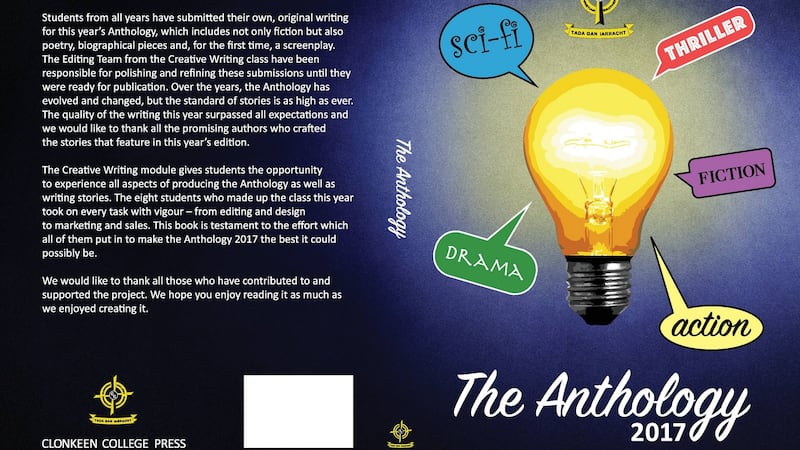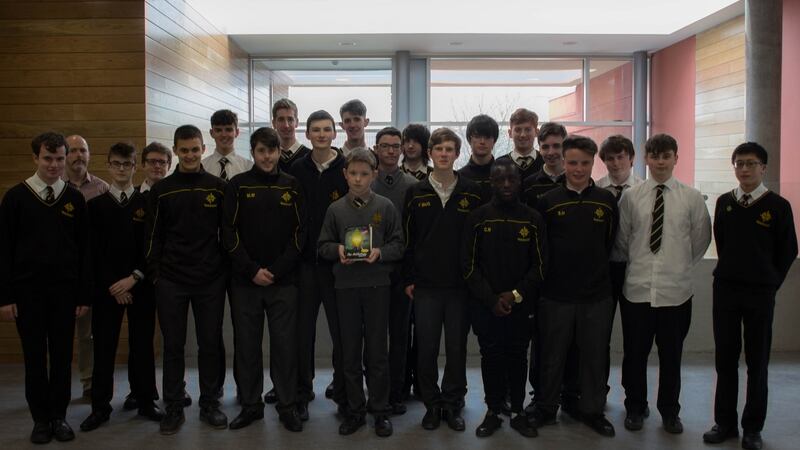In 2012, I had an idea for a project in Clonkeen College but no sense of whether it could be realised. Having written and published two novels at that point, I wanted to create an outlet for students interested in writing and felt the a creative writing module in Transition Year was a good place to start.
The only two things I was sure of (and there were many doubts) was that I wanted the project to yield a physical book and I wanted the course to be a practical exercise in writing and publishing. I wanted the students to understand that writing takes time and discipline, and I wanted them to understand that there is necessary business behind the world of books, without which publishers, editors, bookshops, reviewers, prizes, awards and, most importantly, authors cannot thrive.

It was the latter certainty that led to the establishment of Clonkeen College Press and the publication of our first Anthology in 2012. In the first edition there were stories and poetry from the creative writing class and from a handful of senior students.
We are now on our 6th edition of The Anthology, published in the spring of each year. Over the years it has showcased short stories, biographies, poetry, screenplays, extracts from dramas and artwork from students throughout the school – 1st Year to 6th to past pupils.
This year’s book, The Anthology 2017, includes writing from a 1st Year student, Garvan Moloney, a 3rd Year student, Tom Wallace, the TY students in the creative writing class, 5th Years and 6th Years, and two past pupils. The cover was designed by 3rd Year student, Roman Gyrin.
I have known from the beginning what I wanted the project to be but, in truth, it is only the students themselves who can attest to whether The Anthology has become what I had hoped. Or whether it has become something else, something more or better, or perhaps it is now a mere staple of Clonkeen’s academic year.
Whichever way, it has been a mighty achievement by all the students involved and it seems fitting now to hand this article over to them and to let them have their say, to make their voices heard.
So, “Tada gan iarracht!” as they say round these parts.
The students speak: Alex Cregan (6th Yr) and Ronan Cullen (TY, Chairperson of Clonkeen College Press)
The Clonkeen School Anthology is more than just a method of students sharing their work as writers in a published book. I think it is also a way of seeing the development and capability of young writers in general. Ever since I was a child I’ve loved coming up with stories and writing insane pieces of work that didn’t make sense.
It’s because of John, or Mr Toomey, as we call him here, that I’ve been given the chance to create a story that I’m proud of and have it published. I never thought that I would be given the opportunity to work with an author and enhance my skills as a writer.
The Anthology gives us the freedom to write what we want but is also a place where we are guided through the process of structuring and editing our stories. When the printers sent us the first copy I couldn’t help but smile. It was a real book! A book that I was involved in writing, editing and marketing. It’s a great feeling to see the finished product of something you have worked hard to produce and it’s fulfilling to know that we are continuing the legacy of the Clonkeen Anthology.
When we sought reactions from students about their experience, Finn McGrath, secretary of Clonkeen College Press, 2016-17, told us, “Working on The Anthology has been a very rewarding experience and having our own printed book to show for it now is a great feeling.”
This inspired me to think about why this is the case and what it could mean to the development of writing as a whole. You might be thinking how this applies to The Anthology. It does so in quite a simple and provocative way. The project is a way of giving students confidence by putting their writing into a published book. But I also think it is something more than that. It is a study and a recording of how writing develops in our youth. Most stories in our anthologies have an interesting setting, which was no doubt the inception of their stories. The worlds created are an undiluted and pure expression of imagination.
In understanding this, one sees the beauty of the school anthology. It is not intended to live up to the professional work of mature authors who publish books to sell millions. It is a time capsule that through the years might capture the most crucial stage in a person’s writing life, which I believe to be adolescence. If you read a few stories you’ll immediately be struck by the honesty and openness with which students write. No one writes something they’re not particularly interested in unless they’re being paid for it, and since we’re not being paid, well, we have nothing to motivate us other than our own passions. For this very reason, these stories are the purest form of writing you can find. Their vision is not distorted by any outside forces. They’re written exactly as they are intended to be. Obviously, this leads to some imperfections in the stories but, as I said, that is the beauty of our book.
What’s great about the creative writing class in Clonkeen is there is a genuine enthusiasm for writing. People enjoy doing it and hopefully people will continue doing it, whether as a hobby or in a professional capacity, into their adult years. It’s a stepping stone into the world of literature and it means, as Seán Nolan puts it, “At the end of it all I’m able to call myself a published writer.” Future writers from Clonkeen College might look back upon their time making the anthology and place it as the moment that set them on their path. I’ve definitely realised my love for writing and hopefully others have too.
There is a business to writing, of course, and anyone aspiring to join that business must adhere to the system in place so as to hold a steady position in it. As sixth-year student Kenneth Lee said, “There is more to creating a book then just writing a draft. There are many other details such as editing and proofreading.” Compromises are an inevitable. This is unavoidable, but The anthology lends a valuable insight into the minds of young writers largely unaffected by surrounding influences and unintimidated by the expectations of any demographic. It has a “take it or leave it” attitude.
Unlike any other subject in school, creative writing doesn’t nail down students, doesn’t demand that they write or work on anything in particular. Sixth year student Harry Martin summed it up best when he commented, “That is what makes the anthology so unique; we are given the freedom and encouragement to take it in whatever direction we wish.” The students simply have to write what they’re passionate about – and that’s that!
This is what makes Clonkeen’s anthology so special. The work of the students doesn’t have to be perfect. It doesn’t have to appeal to a certain regime of rules either. The students of the creative writing class make their own rules, other than having specific deadline by which the anthology must be ready. To argue the quality of the anthology would be pointless, as that is not its purpose. Its purpose is to show off how teenagers write, what they write about and, most importantly, to spark that creative flame within the student’s mind and unlock their creative potential.

The Anthology 2017 was launched by writer and illustrator Alan Nolan last week. It costs €6. If you would be interested in buying one, contact John Toomey at clonkeencollegepress@gmail.com
Twitter @CLONKCOLLPRESS
Facebook www.facebook.com/Clonkeen-College-Press

















